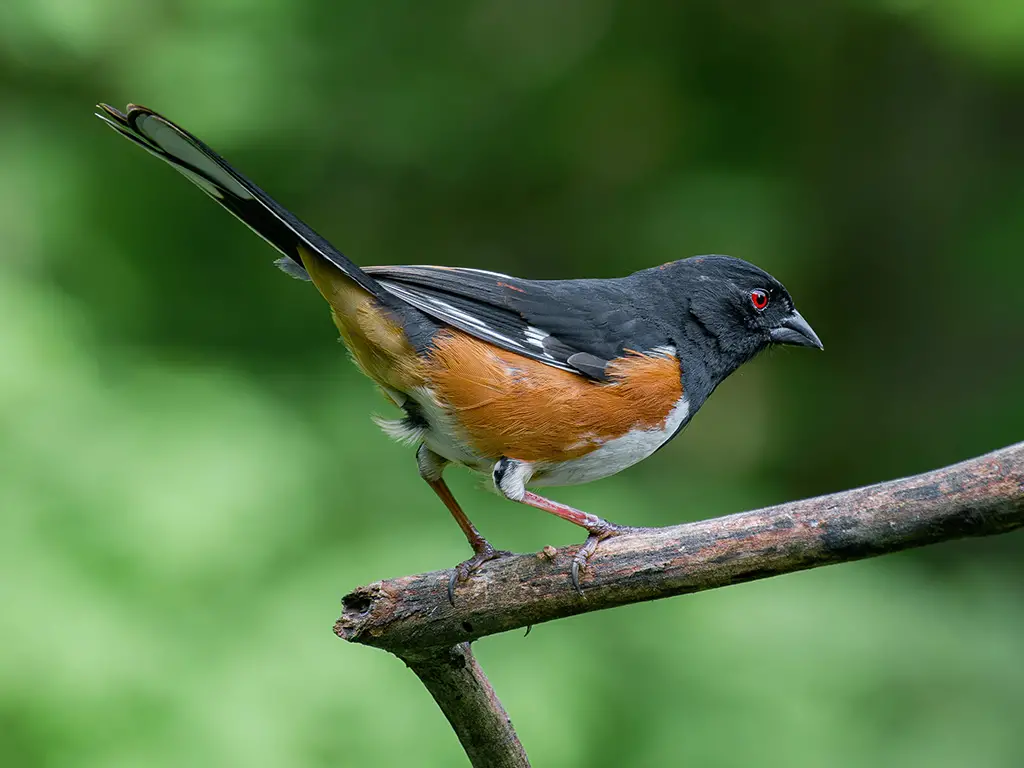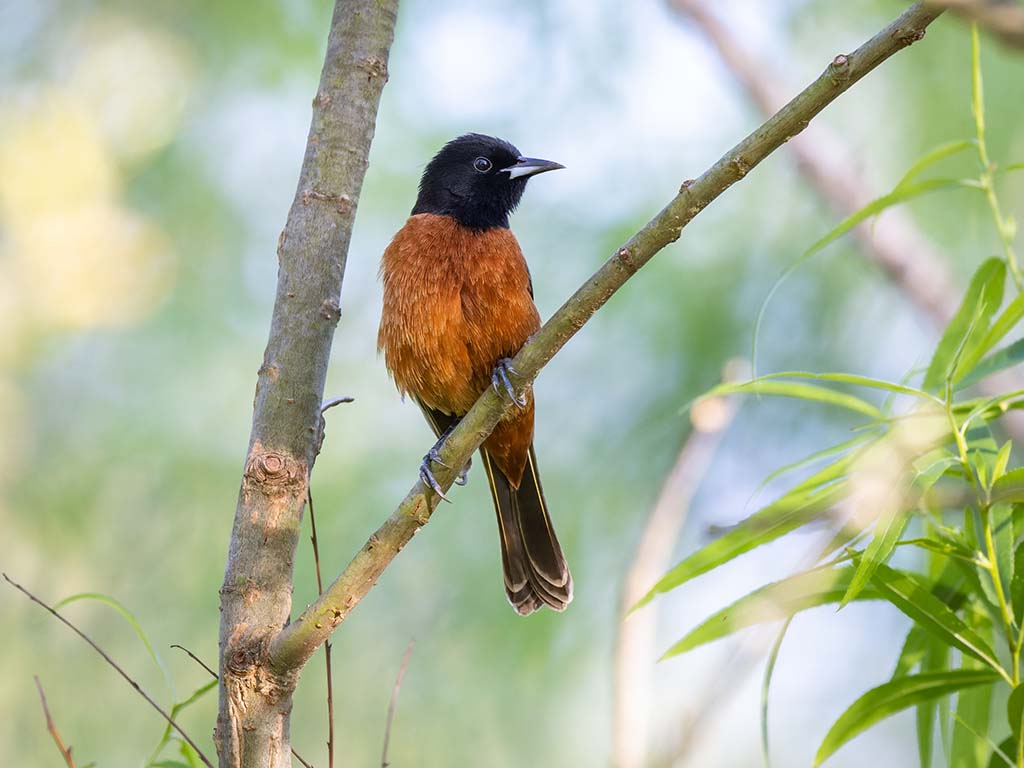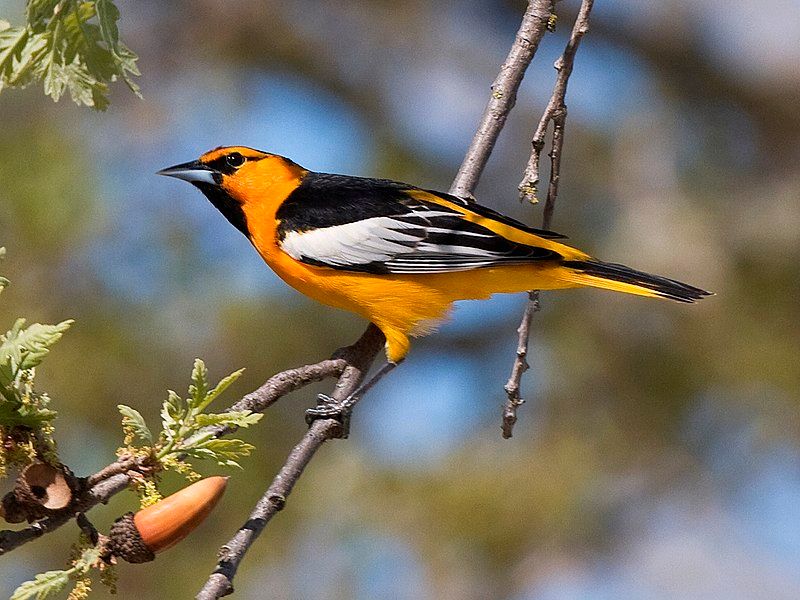Kentucky, known for its lush green landscapes, rolling hills, and diverse wildlife, is home to an array of fascinating avian species.
Among the many bird species that thrive in the state, one particularly captivating variety that captures the attention of bird enthusiasts and nature lovers is the orange bird.
With its vibrant plumage and distinct appearance, the orange bird stands out among the rest, adding a splash of color to the blue skies and verdant forests of Kentucky.
In this article, we will explore the intriguing characteristics, habitat preferences, and behavioral patterns of these delightful orange birds in Kentucky, providing a glimpse into their enchanting presence within the state’s rich avian community.
1. Eastern Towhee

The eastern towhee is a type of sparrow that is found in the New World. It is a relatively large sparrow compared to other species. However, there has been some disagreement among scientists about the classification of towhees in recent years.
In the past, the eastern towhee and the spotted towhee were thought to be the same species called the rufous-sided towhee. The debate about the taxonomy of towhees has caused confusion and uncertainty among experts.
They have been trying to determine the exact relationship between the eastern towhee and the spotted towhee.
This has led to discussions and research to better understand the differences and similarities between these two birds.
Despite the taxonomic debate, it is agreed that the eastern towhee has a specific breeding habitat in brushy areas across eastern North America.
This means that they prefer to build their nests and raise their young in areas that are filled with dense vegetation and shrubs. The brushy areas provide the eastern towhees with the necessary cover and protection for their breeding activities.
These habitats are abundant in eastern North America, making it an ideal place for the eastern towhee to thrive and reproduce. By studying the breeding habitats of the eastern towhee, scientists can gain insights into their.
| Kingdom | Animalia |
| Phylum | Chordata |
| Clade | Dinosauria |
| Class | Aves |
| Order | Passeriformes |
| Family | Passerellidae |
| Genus | Pipilo |
| Species | P. erythrophthalmus |
2. American Robin

The American robin is a type of bird that migrates. It belongs to the true thrush genus and the Turdidae family, which is a larger family of thrushes. It gets its name from the European robin because of its reddish-orange breast.
However, it is important to note that the American robin and the European robin are not closely related. The European robin is a different species and belongs to the Old World flycatcher family.
Despite their similar names and physical characteristics, these two birds are not closely related in terms of their genetic makeup.
They may share some similarities in appearance, such as the reddish-orange breast, but their evolutionary paths have taken them in different directions.
The American robin is primarily found in North America, while the European robin is native to Europe and parts of Asia.
Both species have adapted to their respective environments and habitats over time.
The American robin is known for its ability to migrate long distances, often traveling south during the winter months and returning north for breeding season. In terms of physical characteristics, the American robin is larger than the European robin.
It has a grayish-brown back and a distinct reddish-orange breast, which is a defining feature of the species.
| Kingdom | Animalia |
| Phylum | Chordata |
| Clade | Dinosauria |
| Class | Aves |
| Order | Passeriformes |
| Family | Turdidae |
| Genus | Turdus |
| Species | T. migratorius |
3. Baltimore Oriole

The Baltimore oriole is a type of bird that belongs to the icterid blackbird family. It is found commonly in eastern parts of North America. This bird is known for its tendency to migrate during the breeding season. The reason behind its name is quite fascinating.
It is said that the Baltimore oriole got its name because of the similarity between the male’s colors and the coat-of-arms of Lord Baltimore, who lived in the 17th century.
This suggests that the bird’s vibrant and distinct colors reminded people of the coat of arms. The male Baltimore oriole is particularly known for its striking appearance. It has bright orange plumage on its underparts, while its head, back, and wings are black.
The combination of these contrasting colors makes the male Baltimore oriole stand out in its habitat.
On the other hand, the female Baltimore oriole has a more subdued appearance. Its plumage is primarily yellowish-brown, which helps it blend in better with its surroundings.
This difference in appearance between males and females is a common characteristic among many bird species. In addition to its striking appearance, the Baltimore oriole is also known for its beautiful song. The male bird sings a complex.
| Kingdom | Animalia |
| Phylum | Chordata |
| Clade | Dinosauria |
| Class | Aves |
| Order | Passeriformes |
| Family | Icteridae |
| Genus | Icterus |
| Species | I. galbula |
4. Orchard Oriole

The orchard oriole is a type of bird belonging to the icterid family. It is known for being the smallest species within this family. However, there is a subspecies of the orchard oriole found along the Caribbean coast of Mexico called I. s.
fuertesi.Some experts believe that this subspecies is different enough to be considered a separate species on its own. It is sometimes referred to as the ochre oriole or Fuertes’s oriole.
This indicates that it has distinct characteristics that set it apart from the orchard oriole. The inclusion of “ochre” in its name suggests that this subspecies may have a different coloration compared to the orchard oriole.
This distinction in appearance could be one of the factors contributing to the consideration of I. s.
fuertesi as a separate species. Fuertes’s oriole is named after Louis Agassiz Fuertes, an American ornithologist and bird artist who contributed significantly to the study of birds.
This specific subspecies was likely named in his honor due to his notable contributions to the field of ornithology. The debate surrounding the classification of I. s. fuertesi as.
| Kingdom | Animalia |
| Phylum | Chordata |
| Clade | Dinosauria |
| Class | Aves |
| Order | Passeriformes |
| Family | Icteridae |
| Genus | Icterus |
| Species | I. spurius |
5. Blackburnian Warbler

The Blackburnian warbler is a type of bird that can be found in the New World. It is a small bird and belongs to the warbler family. These birds are known for their vibrant colors and beautiful plumage.
The Blackburnian warbler has a fiery orange throat and breast, which makes it stand out among other warblers.
During the breeding season, Blackburnian warblers can be found in eastern North America. They choose to breed in various habitats such as forests and woodlands.
Their breeding range stretches from southern Canada, all the way to the southern Canadian Prairies. They also breed in the Great Lakes region and New England. These birds prefer to build their nests in tall trees, often near the edges of forests.
The female Blackburnian warbler constructs the nest using materials such as twigs, grass, and moss. After the breeding season, Blackburnian warblers migrate to their wintering grounds. They undertake a long journey south to escape the cold temperatures of North America.
During winter, these warblers can be found in Central and South America. They seek out lush tropical forests and spend their time foraging for insects and other small creatures. The Blackburnian warbler’s migration route takes.
| Kingdom | Animalia |
| Phylum | Chordata |
| Clade | Dinosauria |
| Class | Aves |
| Order | Passeriformes |
| Family | Parulidae |
| Genus | Setophaga |
| Species | S. fusca |
6. American Kestrel

The American kestrel is a type of falcon that can also be known as the sparrow hawk. It is found in North America and is the smallest and most common falcon in the region. The size of the American kestrel can vary depending on the subspecies and the sex of the bird.
Generally, there is a two-to-one range in size between different individuals. When it comes to size, the American kestrel can range from being as small as a blue jay to as large as a mourning dove.
This means that some individuals can weigh as much as a blue jay, while others can be as heavy as a mourning dove. The variation in size within the American kestrel population can be attributed to differences in subspecies and also between males and females.
This means that females may generally be larger than males, and different subspecies may have different average sizes. It is interesting to note that despite this size variation, the American kestrel remains the smallest falcon in North America.
This indicates that even the largest individuals of this species are still relatively small compared to other falcons found in the region. In conclusion, the American kestrel is also known as the sparrow.
| Kingdom | Animalia |
| Phylum | Chordata |
| Clade | Dinosauria |
| Class | Aves |
| Order | Falconiformes |
| Family | Falconidae |
| Genus | Falco |
| Species | F. sparverius |
7. Rufous Hummingbird

The rufous hummingbird is a tiny bird, measuring only about 8 cm in length. It has a distinctive long, straight, and slender bill, which it uses to feed on nectar from flowers. These birds are renowned for their exceptional flight abilities.
During their migratory journeys, they can cover an astonishing distance of up to 2,000 miles. The rufous hummingbird belongs to a group called the Selasphorus genus, which comprises a total of nine different species.
Each species within this genus shares similar characteristics and features. However, the rufous hummingbird is unique in its own way. These birds’ flight skills are truly remarkable.
They are capable of hovering in mid-air, flying forward and backward, and even flying upside down. Their wings beat incredibly fast, allowing them to stay in one place while feeding on nectar.
This agile flight pattern also enables them to catch small insects mid-air, which they supplement their diet with. During their long migratory transits, rufous hummingbirds travel vast distances.
They undertake these journeys in search of suitable breeding grounds and food sources. Despite their small size, these birds possess impressive endurance and determination to reach their destinations.
| Kingdom | Animalia |
| Phylum | Chordata |
| Clade | Strisores |
| Class | Aves |
| Order | Apodiformes |
| Family | Trochilidae |
| Genus | Selasphorus |
| Species | S. rufus |
8. Black-Headed Grosbeak

The black-headed grosbeak is a bird that belongs to the family Cardinalidae. It is not a very large bird, but it is also not very small either. This bird primarily feeds on seeds.
Interestingly, there is another bird called the rose-breasted grosbeak that is closely related to the black-headed grosbeak.
These two birds are so similar that they can actually mate and produce offspring together. The black-headed grosbeak and the rose-breasted grosbeak can hybridize.
Hybridization occurs when two different species mate and produce offspring that have a combination of traits from both parents.
This phenomenon happens specifically on the American Great Plains. Some experts even consider the black-headed grosbeak and the rose-breasted grosbeak to be the same species because they can interbreed.
When two species can successfully produce fertile offspring, they are often considered to be the same species.
However, not all experts agree on whether the black-headed grosbeak and the rose-breasted grosbeak should be considered the same species.
Some argue that even though they can hybridize, there are still enough differences between them to classify them as separate species. It is fascinating to observe how these two birds can interact.
| Kingdom | Animalia |
| Phylum | Chordata |
| Clade | Dinosauria |
| Class | Aves |
| Order | Passeriformes |
| Family | Cardinalidae |
| Genus | Pheucticus |
| Species | P. melanocephalus |
9. Carolina Wren

The Carolina wren is a type of wren bird that can be found in several regions. It is considered a common species, meaning it is frequently seen in these areas. The bird is mainly found in the eastern half of the United States of America.
This includes states like North Carolina, South Carolina, and Virginia. However, it can also be spotted in other states within this region. Apart from the United States, the Carolina wren is also seen in certain parts of Canada.
Specifically, it can be found in the extreme south of Ontario. This means that it is only present in the southernmost part of the province.
This is interesting because the bird’s range extends beyond the borders of the United States. Additionally, the Carolina wren can be observed in the extreme northeast of Mexico.
This means that it is found in the northeastern part of the country, close to the border it shares with the United States.
This further highlights the bird’s ability to inhabit different regions within North America. Overall, the Carolina wren is a resident bird in the eastern half of the United States, the extreme south of Ontario, Canada, and the extreme northeast of Mexico.
It is a common species, often seen in these areas. Its range includes several states.
| Kingdom | Animalia |
| Phylum | Chordata |
| Clade | Dinosauria |
| Class | Aves |
| Order | Passeriformes |
| Family | Troglodytidae |
| Genus | Thryothorus |
| Species | T. ludovicianus |
10. Bullock’s Oriole

The Bullock’s oriole is a type of blackbird found in the New World. It is relatively small in size compared to other blackbird species.
In the past, the Bullock’s oriole and the Baltimore oriole were thought to be the same species and were known as the northern oriole. The Bullock’s oriole is named after William Bullock, who was an amateur naturalist from England.
William Bullock had a keen interest in studying and observing various aspects of nature, including birds.
As a tribute to his contributions to the field of natural history, this particular bird species was named after him. It is important to note that the Bullock’s oriole and the Baltimore oriole have distinct characteristics that differentiate them as separate species.
While they may share some similarities, such as their vibrant plumage and their affiliation with the oriole family, they have unique features that set them apart.
The Bullock’s oriole is known for its bright orange plumage, with black markings on its back and wings.
In contrast, the Baltimore oriole has a predominantly black and orange coloration, with a black head and back, and orange underparts. These differences help with.
| Kingdom | Animalia |
| Phylum | Chordata |
| Clade | Dinosauria |
| Class | Aves |
| Order | Passeriformes |
| Family | Icteridae |
| Genus | Icterus |
| Species | I. bullockii |
Conclusion
Orange birds in Kentucky are a rare and fascinating sight. The presence of these vibrant and colorful birds adds beauty and diversity to the state’s bird population.
While their exact species may still be a mystery, their unique appearance and behavior make them a subject of interest among bird enthusiasts and researchers.
Preserving their habitats and maintaining conservation efforts will be crucial to ensure the continued existence of orange birds in Kentucky.
By appreciating and protecting these beautiful creatures, we can contribute to the conservation of Kentucky’s natural heritage.